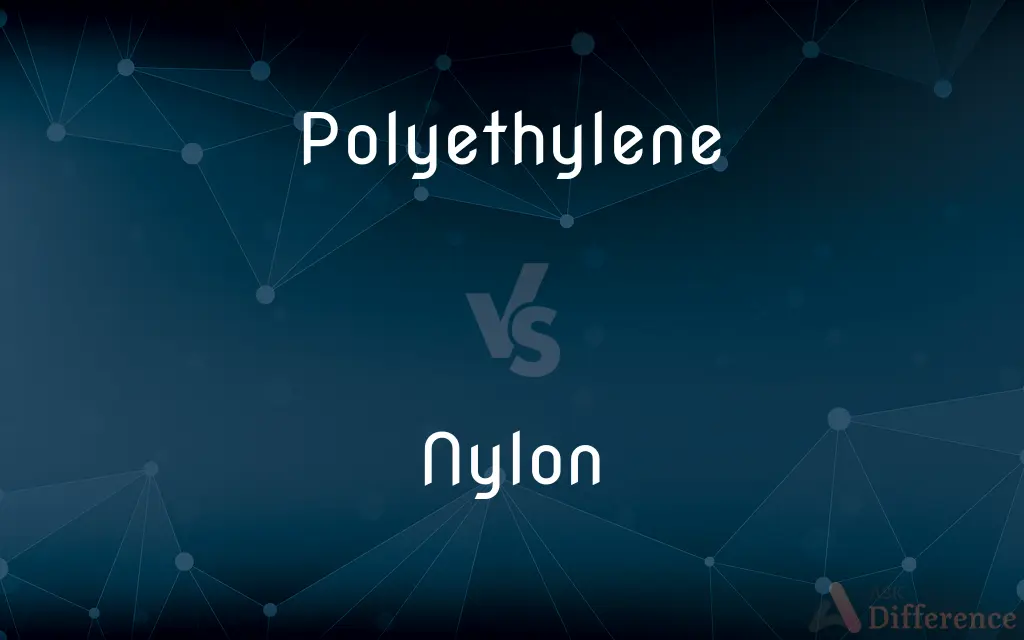Polyethylene vs. Nylon — What's the Difference?
By Tayyaba Rehman & Fiza Rafique — Updated on September 14, 2023
Polyethylene is a versatile, lightweight plastic made from ethylene gas, commonly used in packaging and containers. Nylon is a strong, synthetic fiber made from polyamides, often used in textiles and automotive applications.

Difference Between Polyethylene and Nylon
Table of Contents
ADVERTISEMENT
Key Differences
Polyethylene is one of the most widely used plastics in the world, known for its lightweight, durable nature. Nylon, on the other hand, is a synthetic polymer that's most commonly formed into fibers for use in textiles. Polyethylene is generally easier to produce and is less costly compared to nylon.
In terms of applications, polyethylene is frequently used in packaging, plastic bags, and bottles. Nylon finds its utility in areas such as clothing, ropes, and automotive parts. While polyethylene excels in moisture resistance, nylon has superior strength and heat resistance, making it suitable for more demanding applications.
Polyethylene comes in different densities like LDPE (Low-Density Polyethylene) and HDPE (High-Density Polyethylene), each with specific uses. Nylon, meanwhile, comes in various forms like Nylon 6,6 or Nylon 6, which differ in molecular structure and, consequently, in their properties.
From a chemical perspective, polyethylene is a polymer of ethylene, a hydrocarbon. Nylon is a polyamide, made from reacting a diamine and a dicarboxylic acid. The two materials differ substantially in chemical composition, which accounts for their different properties and applications.
Comparison Chart
Basic Composition
Polymer of ethylene
Polyamide
ADVERTISEMENT
Common Uses
Packaging, bottles
Textiles, automotive
Cost
Generally cheaper
More expensive
Strength and Durability
Moderate
High
Types
LDPE, HDPE
Nylon 6,6, Nylon 6
Compare with Definitions
Polyethylene
Commonly used in packaging.
Polyethylene bags are commonly seen in grocery stores.
Nylon
A strong synthetic fiber.
Nylon ropes are known for their strength.
Polyethylene
A lightweight, versatile plastic.
Polyethylene is often used for disposable water bottles.
Nylon
Made from polyamides.
Nylon is a polyamide, giving it unique characteristics.
Polyethylene
Resistant to moisture.
Polyethylene is often used for outdoor furniture because it resists moisture.
Nylon
Comes in different forms.
Nylon 6 and Nylon 6,6 have different molecular structures.
Polyethylene
Comes in different densities.
HDPE is a type of polyethylene used for sturdy containers.
Nylon
Resistant to heat and wear.
Nylon is often used in cookware because it can withstand heat.
Polyethylene
Made from ethylene gas.
The production of polyethylene starts with ethylene as a raw material.
Nylon
Used in textiles and automotive applications.
Car seat belts often use nylon for its durability.
Polyethylene
Polyethylene or polythene (abbreviated PE; IUPAC name polyethene or poly(methylene)) is the most common plastic in use today. It is a polymer, primarily used for packaging (plastic bags, plastic films, geomembranes and containers including bottles, etc.).
Nylon
Nylon is a generic designation for a family of synthetic polymers composed of polyamides (repeating units linked by amide links). Nylon is a silk-like thermoplastic, generally made from petroleum, that can be melt-processed into fibers, films, or shapes.
Polyethylene
A polymerized thermoplastic ethylene resin, used especially for containers, kitchenware, and tubing, or in the form of films and sheets for packaging.
Nylon
Any of a family of high-strength, resilient synthetic polymers, the molecules of which contain the recurring amide group CONH.
Polyethylene
(organic compound) A polymer consisting of many ethylene monomers bonded together; used for kitchenware, containers etc.
Nylon
Cloth or yarn made from one of these synthetic materials.
Polyethylene
A lightweight thermoplastic; used especially in packaging and insulation
Nylon
Nylons Stockings made of one of these synthetic materials.
Nylon
Originally, the DuPont company trade name for polyamide, a copolymer whose molecules consist of alternating diamine and dicarboxylic acid monomers bonded together; now generically used for this type of polymer.
Nylon
(in the plural) A stocking originally fabricated from nylon; also used generically for any long, sheer stocking worn on a woman's legs.
I tore a hole in my nylons while walking home through the woods.
Nylon
(perjoratively, by comparison to silk) A Queen's Counsel, King's Counsel or Senior Counsel who was appointed as a courtesy, rather than on merit.
Nylon
Any of several thermoplastic polyamide plastics, comprising a family of high-strength resilient synthetic materials, used mostly in fibers.
Nylon
A synthetic fabric consisting of fibers of nylon[wn1].
Nylon
Stockings made of a thin form of nylon{2}, especially full-length stockings either sheer of of varying shades.
Nylon
A thermoplastic polyamide; a family of high-strength resilient synthetic materials
Nylon
A synthetic fabric
Common Curiosities
What are common uses for Polyethylene?
It's commonly used in packaging, plastic bags, and bottles.
How is Polyethylene made?
It is made by polymerizing ethylene gas.
How is Nylon made?
It is made by reacting a diamine and a dicarboxylic acid.
Is Polyethylene expensive?
It's generally cheaper compared to nylon.
Is Nylon strong?
Yes, it's known for its high strength and durability.
Is Nylon heat-resistant?
Yes, it can withstand high temperatures.
What is Nylon?
Nylon is a strong synthetic fiber made from polyamides.
What is Polyethylene?
Polyethylene is a lightweight, versatile plastic made from ethylene gas.
Is Nylon expensive?
It tends to be more expensive due to its more demanding production process.
Are there different types of Nylon?
Yes, like Nylon 6 and Nylon 6,6.
What are common uses for Nylon?
It's commonly used in textiles, ropes, and automotive applications.
Is Polyethylene strong?
It has moderate strength and is less durable than nylon.
Can Polyethylene and Nylon be recycled?
Both can be recycled, but the processes differ and may have limitations.
Are there different types of Polyethylene?
Yes, like LDPE and HDPE.
Is Polyethylene moisture-resistant?
Yes, it's highly moisture-resistant.
Share Your Discovery

Previous Comparison
Essence vs. Scent
Next Comparison
Mystical vs. MagicalAuthor Spotlight
Written by
Tayyaba RehmanTayyaba Rehman is a distinguished writer, currently serving as a primary contributor to askdifference.com. As a researcher in semantics and etymology, Tayyaba's passion for the complexity of languages and their distinctions has found a perfect home on the platform. Tayyaba delves into the intricacies of language, distinguishing between commonly confused words and phrases, thereby providing clarity for readers worldwide.
Co-written by
Fiza RafiqueFiza Rafique is a skilled content writer at AskDifference.com, where she meticulously refines and enhances written pieces. Drawing from her vast editorial expertise, Fiza ensures clarity, accuracy, and precision in every article. Passionate about language, she continually seeks to elevate the quality of content for readers worldwide.













































